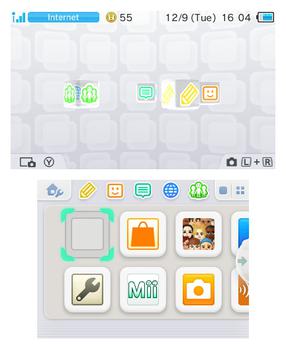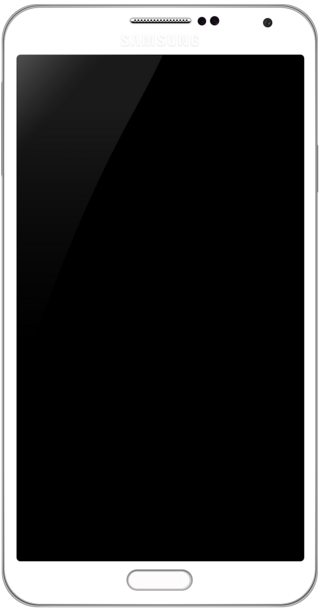Related Research Articles

In computing, booting is the process of starting a computer as initiated via hardware such as a button or by a software command. After it is switched on, a computer's central processing unit (CPU) has no software in its main memory, so some process must load software into memory before it can be executed. This may be done by hardware or firmware in the CPU, or by a separate processor in the computer system.

A smartphone is a mobile device that combines the functionality of a traditional mobile phone with advanced computing capabilities. It typically has a touchscreen interface, allowing users to access a wide range of applications and services, such as web browsing, email, and social media, as well as multimedia playback and streaming. Smartphones also have built-in cameras, GPS navigation, and support for various communication methods, including voice calls, text messaging, and internet-based messaging apps.
In user interface design, a menu is a list of options presented to the user.
A default, in computer science, refers to the preexisting value of a user-configurable setting that is assigned to a software application, computer program or device. Such settings are also called presets or factory presets, especially for electronic devices.
In computing, a non-maskable interrupt (NMI) is a hardware interrupt that standard interrupt-masking techniques in the system cannot ignore. It typically occurs to signal attention for non-recoverable hardware errors. Some NMIs may be masked, but only by using proprietary methods specific to the particular NMI. With regard to SPARC, the non-maskable interrupt (NMI), despite having the highest priority among interrupts, can be prevented from occurring through the use of an interrupt mask.

The Sony Ericsson K800i, and its variant, the Sony Ericsson K790, are mobile phone handsets manufactured by Sony Ericsson. Launched in July 2006, the phones are the successor to the Sony Ericsson K750i, and are the first to be tagged with the Sony Cyber-shot branding. Both of the phones feature a 3.2-megapixel digital camera complete with a xenon flash, a protective lens cover, and a new "BestPic" bracketing feature. The new "BestPic" feature takes 9 full quality snapshots of a subject in quick succession, allowing the user to choose the best shots from them. On the entertainment front, the phones have a media player supporting MP3, AAC/AAC+/eAAC+ and WMA music files and 3GP/MPEG-4 video files. The phones also feature a RDS FM radio, and a Memory Stick Micro (M2) slot for expandable solid state memory. The K790/K800 models are also the first Sony Ericsson mobile phones to use ATI's Imageon 2192 graphics engine, which delivers a full 3D gaming graphics for Java and full support for its 3.2-megapixel camera. It is the phone used by James Bond in the 2006 Casino Royale film and trailers.

A brick is a mobile device, game console, router, computer or other electronic device that is no longer functional due to corrupted firmware, a hardware problem, or other damage. The term analogizes the device to a brick's modern technological usefulness.
In a computer or data transmission system, a reset clears any pending errors or events and brings a system to normal condition or an initial state, usually in a controlled manner. It is usually done in response to an error condition when it is impossible or undesirable for a processing activity to proceed and all error recovery mechanisms fail. A computer storage program would normally perform a "reset" if a command times out and error recovery schemes like retry or abort also fail.
Data erasure is a software-based method of data sanitization that aims to completely destroy all electronic data residing on a hard disk drive or other digital media by overwriting data onto all sectors of the device in an irreversible process. By overwriting the data on the storage device, the data is rendered irrecoverable.
Rooting is the process by which users of Android devices can attain privileged control over various subsystems of the device, usually smartphones. Because Android is based on a modified version of the Linux kernel, rooting an Android device gives similar access to administrative (superuser) permissions as on Linux or any other Unix-like operating system such as FreeBSD or macOS.
The HTC Evo Shift 4G is a smartphone developed by HTC Corporation and marketed as the concurrent/sequel to Sprint's flagship Android smartphone, running on its 4G WiMAX network. The smartphone launched on January 9, 2011.

The Nintendo 3DS system software is the updatable operating system used by the Nintendo 3DS handheld system. The Nintendo Switch system software is believed to have evolved from the Nintendo 3DS system software.
In computing, rebooting is the process by which a running computer system is restarted, either intentionally or unintentionally. Reboots can be either a cold reboot in which the power to the system is physically turned off and back on again ; or a warm reboot in which the system restarts while still powered up. The term restart is used to refer to a reboot when the operating system closes all programs and finalizes all pending input and output operations before initiating a soft reboot.

ChatON was a global mobile communication service provided by Samsung Electronics from September 2011 to March 2015.

The Samsung Galaxy Note 3 is an Android phablet smartphone produced by Samsung Electronics as part of the Samsung Galaxy Note series. The Galaxy Note 3 was unveiled on September 4, 2013, with its worldwide release beginning later in the month. Serving as a successor to the Galaxy Note II, the Note 3 was designed to have a lighter, more upscale design than previous iterations of the Galaxy Note series, and to expand upon the stylus and multitasking-oriented functionality in its software—which includes a new pie menu opened through the button on the stylus for quick access to pen-enabled apps, along with pop-up apps and expanded multi-window functionality. It additionally features new sensors, a USB 3.0 port, 3 GB of RAM, and its video camera has been upgraded to 2160p (4K) resolution and doubled framerate of 60 at 1080p, placing it among the earliest smartphones to be equipped with any of these.
A hardware reset or hard reset of a computer system is a hardware operation that re-initializes the core hardware components of the system, thus ending all current software operations in the system. This is typically, but not always, followed by booting of the system into firmware that re-initializes the rest of the system, and restarts the operating system.
Samsung Galaxy Star 2 Plus G350E is a smartphone manufactured by Samsung Electronics that runs on the open source Android operating system. Announced by Samsung in early August 2014. It has additional software features, expanded hardware, and a redesigned physique from its predecessor, the Samsung Galaxy Star 2.

Nearby Share was a functionality developed by Google that allows data to be transferred between devices via Bluetooth and Wi-Fi. It is available on their mobile and desktop operating systems, Android and ChromeOS, as well as Microsoft's Windows. Nearby Share uses Bluetooth, Bluetooth Low Energy, WebRTC, UWB, and peer-to-peer Wi-Fi to allow users to share files and links between devices. It was first released on August 4, 2020.

The Android recovery mode is a mode of Android used for installing updates and wipe data. It consists of a Linux kernel with ramdisk on a separate partition from the main Android system.
References
- 1 2 "hard reset (factory reset; master reset)". whatis.techtarget.com. Retrieved 23 October 2013.
- ↑ "Guide for Performing Factory Resets on Common Mobile Devices" (PDF). Archived from the original (PDF) on 13 November 2013. Retrieved 23 October 2013.
- ↑ Thomas, Arun (2016-09-08). "How To Remove FRP Lock On Samsung Galaxy Android Smartphone? (Updated)". SamsungSFour.Com. Retrieved 2022-10-19.
- ↑ Jaromír Hořejší (9 July 2014). "Android Forensics, Part 1: How we recovered (supposedly) erased data".
- ↑ "Service Menu Instructions" (MediaWiki).
- ↑ Sonic Rush Instruction Booklet. SEGA. p. 15.
Delete Record: Delete all saved data on the Game Card.
- ↑ Mario Kart: Super Circuit Instruction Booklet. Nintendo of America. p. 12.
To erase all of your saved data, hold the L Button, R Button, B Button and START when you turn the power ON, then choose "Yes" when the confirmation message appears.
- ↑ "Elite Beat Agents Instruction Booklet" (PDF). Nintendo of America. p. 11. Retrieved 15 September 2021.
Deleting Saved Data: When you see [the opening logos], press and hold A + B + X + Y + L + R at the same time to delete saved data.